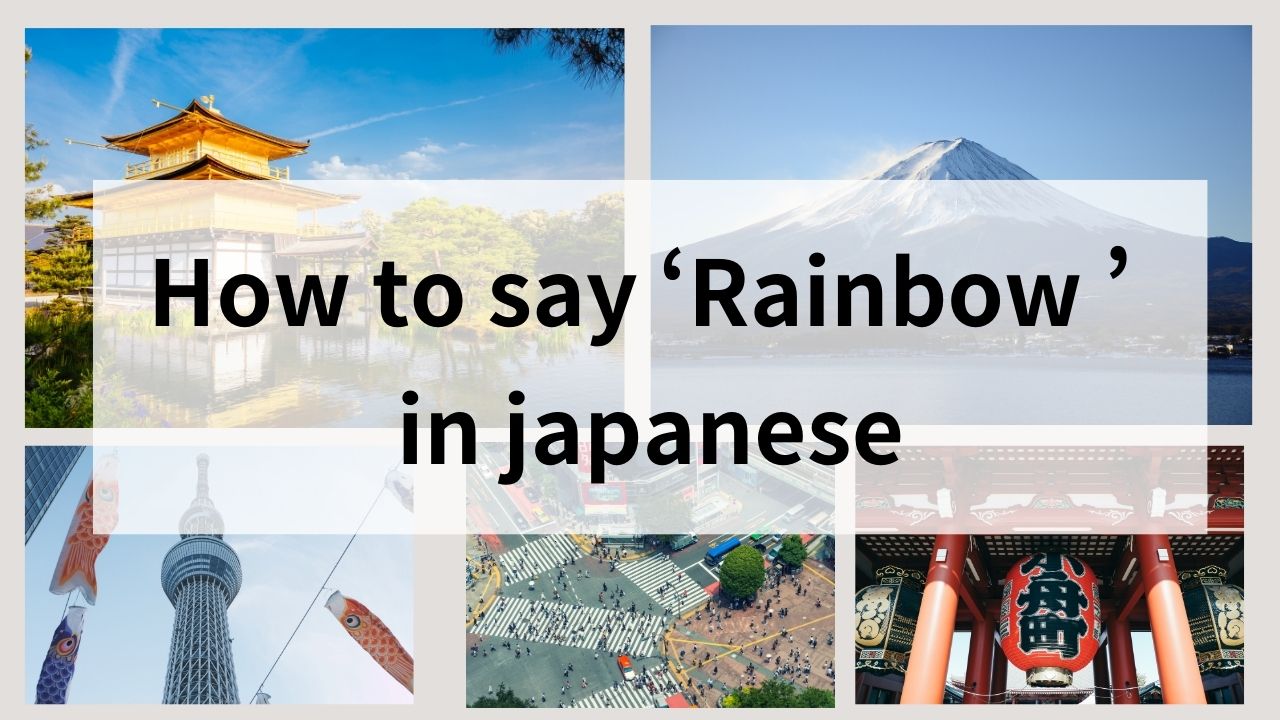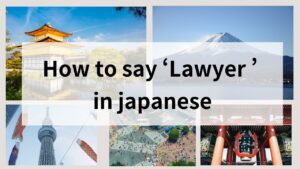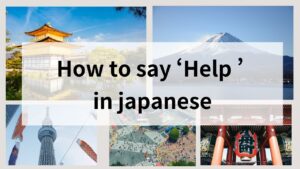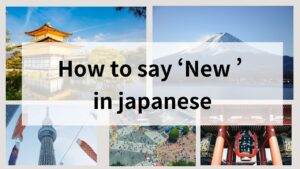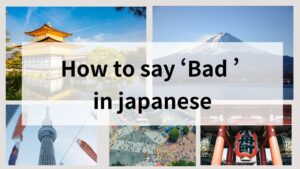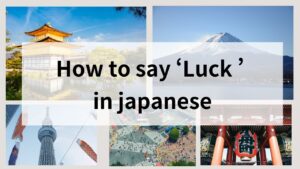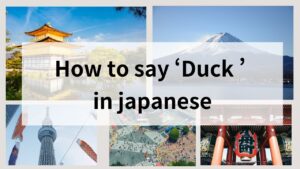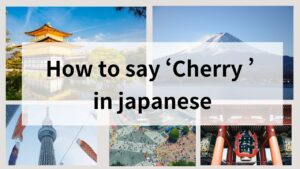Are you curious about how to say “rainbow” in Japanese? The phenomenon of a rainbow holds various cultural meanings and associations in Japan, from nature to symbolism. This guide will explore the Japanese word for “rainbow,” its cultural significance, and practical applications.
How Do You Say “Rainbow” in Japanese?
The Japanese word for “rainbow” is 虹 (niji). This term is widely recognized and used in both casual and formal contexts. The rainbow is a beautiful natural occurrence that has inspired various cultural expressions and meanings in Japan.
The Japanese Word for Rainbow: Niji (虹)
“Niji” is the term used to describe a rainbow and appears in various phrases and contexts. For example:
- 虹の橋 (Niji no hashi): “Rainbow bridge.”
- 虹を見る (Niji wo miru): “To see a rainbow.”
- 虹色 (Nijiiro): “Rainbow-colored.”
Kanji for Rainbow: 虹
The kanji for rainbow, 虹, is often used in literature, poetry, and everyday language. This visually striking character reflects the beauty and complexity of the rainbow’s colors. The primary reading for this kanji is にじ (Niji), which is commonly used in conversations.
Examples of words containing the kanji 虹 include:
- 虹の天使 (Niji no tenshi): “Rainbow angel,” often used in art and poetry to symbolize hope.
- 虹の七色 (Niji no nanairo): “The seven colors of the rainbow,” referring to the common spectrum of colors seen in a rainbow.
This kanji is commonly associated with the beauty and transience of nature, often evoking feelings of wonder and inspiration. Recognizing these patterns can help learners understand the nuanced use of 虹 in Japanese.
Does “Rainbow” Work in Japanese?
The English word “rainbow” is generally understood in Japan, particularly among younger generations or those familiar with Western culture. However, its recognition might be less universal among older individuals or in more traditional contexts. A 5-point scale rates its comprehension as:
- Rating: 4 – Generally understood (60-80% of people)
Rating Details
Understanding the 5-Point Rating for English Words in Japan
The following ratings help explain how English words are typically understood in Japan. The scale is based on context, familiarity, and the target audience.
- 5 - Universally understood (80% or more):
Words that are widely adopted into everyday Japanese, such as "coffee" (コーヒー) or "computer" (コンピューター). These words are part of the standard vocabulary and are recognized by nearly everyone. - 4 - Generally understood (60-80%):
Words that are familiar to most people but might require context for full comprehension. Examples include terms commonly used in specific industries or by younger generations. - 3 - Understood in half of the cases (40-60%):
Words that depend heavily on pronunciation or context. For example, technical terms or less common foreign words that some people may not immediately recognize. - 2 - May not be understood (20-40%):
Words that are unfamiliar to most Japanese speakers unless they have significant exposure to English or specific cultural contexts. These words are often better replaced with their Japanese equivalents. - 1 - Rarely understood (20% or less):
Highly specialized or obscure terms that are unlikely to be recognized by the general public. Clear communication requires the use of Japanese vocabulary or additional explanation.
This rating system provides a practical guide for determining when and how to use English words effectively in Japan. Understanding the audience and context is key to ensuring clear communication.
If clarity is crucial, using the Japanese term にじ (Niji) or 虹色 (Nijiiro) is recommended. While “rainbow” may be understood in certain contexts, “niji” ensures effective communication.
The Cultural Significance of Rainbows in Japan
Rainbows have held a special place in Japanese culture, symbolizing hope, beauty, and the connection between the earthly and the divine. They are often seen as omens of good fortune and are celebrated in various festivals and art forms.
Rainbows as Symbols of Hope
In Japanese folklore, rainbows are seen as bridges between realms, connecting the human world with the spiritual. This symbolism of connection and hope is prevalent in literature and poetry.
Rainbows in Japanese Folklore and Mythology
Rainbows appear in various Japanese myths and stories, often symbolizing renewal and the promise of brighter days. They are sometimes connected to deities and nature, enhancing their significance in cultural narratives.
In modern Japanese pop culture, rainbows are frequently depicted in anime and games as symbols of joy and magic, further emphasizing their positive connotations.
- My Neighbor Totoro: The character Totoro is often associated with rainbows, symbolizing the beauty of nature and childhood wonder.
- One Piece: The “Sky Island” arc features rainbows as a symbol of dreams and adventure, highlighting their inspirational qualities.
- Pokemon: Rainbow-themed Pokémon, such as Ho-Oh, represent hope and renewal in the series.
These examples demonstrate how rainbows continue to represent hope, beauty, and the connection between different realms in both traditional and modern storytelling.
Differences Between Rainbows in Japan and Overseas
There can be subtle differences in how “rainbow” is perceived in Japan versus Western cultures. In Japan, “niji” (虹) often embodies a more serene and spiritual quality, symbolizing harmony with nature. In Western contexts, rainbows are commonly associated with vibrant colors and joy, often linked to celebrations and festivities. Understanding these cultural nuances can help avoid confusion when discussing rainbows or their symbolism.
Practical Applications of “Rainbow” in Japanese
Learning how “rainbow” is used in Japanese can help you navigate conversations, understand idioms, and recognize its presence in Japanese culture.
Talking About Rainbows in Daily Conversation
Here are some examples of how “niji” is used in everyday conversation:
- 虹が見えます (Niji ga miemasu): “I can see a rainbow.”
- 虹の色は美しいです (Niji no iro wa utsukushii desu): “The colors of the rainbow are beautiful.”
Rainbow-Related Idioms or Expressions
While there are relatively few specific idioms involving “niji,” the rainbow is often associated with themes of beauty, hope, and joy in Japanese culture. Here are some expressions that incorporate or symbolize rainbows:
- 虹のような笑顔 (Niji no you na egao): “A smile like a rainbow,” symbolizing joy and positivity.
- 虹色の夢 (Nijiiro no yume): “Rainbow-colored dreams,” representing diverse aspirations and hopes.
- 虹の橋を渡る (Niji no hashi wo wataru): “To cross the rainbow bridge,” often symbolizing transitioning to a better place or new beginnings.
- 虹の七色 (Niji no nanairo): “The seven colors of the rainbow,” referring to the spectrum and its beauty.
These expressions reflect the appreciation of rainbows in Japan, often tied to themes of beauty, hope, and spirituality. By learning these phrases, you can gain a deeper understanding of how rainbows are interwoven with Japanese language and values.
Rainbows in Japanese Cuisine or Products
Rainbows are also celebrated in Japanese cuisine and products, showcasing their aesthetic appeal and symbolism. Here are some notable examples:
- Rainbow-colored desserts (虹色のデザート, Nijiiro no dezāto): Many Japanese desserts feature a variety of colors, resembling a rainbow, often found in traditional sweets like wagashi.
- Rainbow sushi (虹色の寿司, Nijiiro no sushi): A colorful sushi roll made with different ingredients to create a vibrant appearance.
- Rainbow fish (虹色の魚, Nijiiro no sakana): Some fish, like the rainbow trout, are popular for their colorful appearance and are often featured in Japanese cuisine.
These examples highlight how rainbows are not just beautiful natural phenomena but also hold cultural significance in Japanese cuisine, adding richness and vibrancy to dishes.
FAQs
Here are some frequently asked questions about rainbows in Japanese culture and language.
Is Rainbow a Popular Symbol in Japan?
Yes, rainbows are a popular symbol in Japan, representing beauty, hope, and the connection between the earthly and the divine. They are frequently used in art, literature, and celebrations.
How Do You Write “Rainbow” in Japanese?
The word “rainbow” can be written in three different scripts in Japanese: hiragana, katakana, and kanji. Each script serves different purposes depending on the context and formality. Here’s a breakdown:
- Hiragana (にじ, Niji):
Hiragana is the most commonly used script for “rainbow” in casual writing or when teaching children. It is simple and easy to read, making it ideal for everyday use. - Katakana (ニジ, Niji):
Katakana is rarely used for “rainbow,” but it may appear in stylistic contexts, such as advertisements or product names. - Kanji (虹, Niji):
Kanji is the most formal and traditional way to write “rainbow.” It is often used in literature, art, and cultural contexts. The kanji itself conveys a sense of beauty and significance.
Choosing which script to use depends on the tone, audience, and purpose of your communication. Understanding these variations can enhance both your written and spoken Japanese skills.
Conclusion
Rainbow, or “niji” in Japanese, is more than just a natural phenomenon—it symbolizes hope, beauty, and cultural significance. By understanding its role in Japanese language and traditions, you can deepen your appreciation for this colorful symbol and its place in Japanese society.
